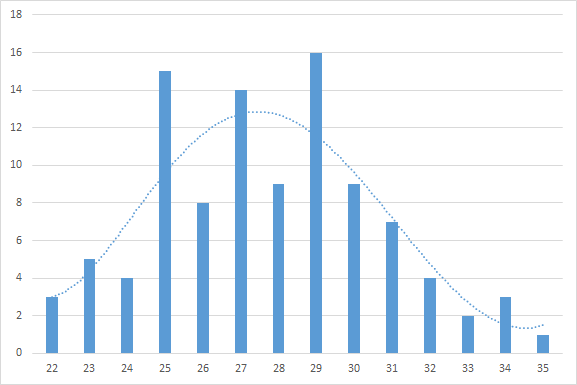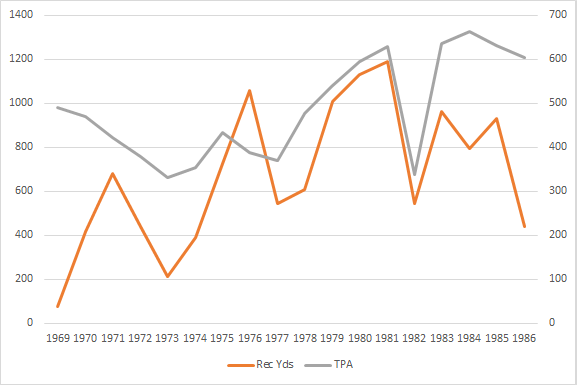On Thursday, I spent some time looking at the underrated career of Joey Galloway. After playing with bad quarterbacks most of his career, Galloway finally broke out with some of the best seasons of his career with Jon Gruden and the Bucs. In fact, Galloway set his career high in receiving yards at age 34, which is pretty rare.
How rare? Well, I was curious about that, too. So I looked at the players with the 100 most receiving yards in football history, and then checked to see how old they were during their top season in receiving yards. [1]Because passing has become progressively easier, some players probably set career highs later in their career based more on the league’s passing environment changing than anything else. … Continue reading The graph below shows the results: 16 of those 100 players had their top season at age 29, 15 at age 25, and 14 at age 27.

Irving Fryar is the sole player to have his best season at age 35. At least statistically, Fryar is one of the ultimate late bloomers. From ages 31 to 35, he ranks 4th in receiving yards. He set a career high with receiving yards at age 29… then did it again at age 32… and then for the last time at age 35. And he did it while playing with Ty Detmer and Bobby Hoying and the ’97 Philadelphia Eagles.
In addition to Galloway, Charlie Joiner and Bobby Engram also had their top receiving seasons at age 34. Joiner is a weird player that has confounded statistical analysts for years. He had some solid but unspectacular seasons with the Oilers and Bengals in his 20s, before joining Dan Fouts and the Chargers at age 29 in 1976. That year, Joiner set a career high with 1,056 yards, 330 more than he had gained in any season prior to joining the Chargers. Then, after a couple of unremarkable years, he began a 3-year string of 1,000-yard seasons as the Chargers fielded the top passing attack in the NFL. He set a career high with 1,132 yards at age 33 and then topped it with 1,188 yards the following season.
Of course, with Joiner, his peak wasn’t just about playing with Fouts, but about playing on pass-happy teams. In the graph below, the orange line is plotted against the left Y-axis, and shows Joiner’s receiving yards by year. The gray line is plotted against the right Y-axis, and shows his team’s number of pass attempts by year. The dip in ’82 is due to the strike, of course, but there’s some reasonable explanations for why Joiner’s best numbers came later in his career.

For Engram, it’s not nearly as clear. He played with the Bears for the first five seasons of his career, so by definition, he was stuck with some pretty poor quarterbacks. Still, he hit 900 yards at age 25 and again at age 26, before failing to hit 800 yards at any point over his next seven seasons. Then, at age 34, he had an out-of-nowhere 1,147 receiving yards. This was in 2007, when the wheels had fallen off the Shaun Alexander train, and the Seahawks ranked 2nd in the NFL with 590 pass attempts. So yes, a pass-happy offense did help, as did the departure of Darrell Jackson, the team’s leading receiver in ’06. But there was no expectation entering 2007 that Engram would do much of anything: in fantasy football, he was the 83rd drafted wide receiver that year. The peak craziness? A 21-target game against the Browns in October.
Who had their best season at age 33? Why Jerry Rice, of course. Oh and Haven Moses. For Rice, an insane number of pass attempts also provides some of the explanation. I have previously written about the ’95 49ers, as they were the single most pass-happy team in NFL history after accounting for Game Script. Despite finishing with the best points differential in the league, the 49ers threw an incredible 644 passes, allowing Rice to set the single-season receiving yards record. As for Moses, he benefited a bit from the rules changes, as his age 33 season came in 1979. He was a solid receiver for a decade, but then set a career high with 943 yards with the ’79 Broncos as Denver turned the corner towards pass-happy. [2]While we also have the 16-game schedule being introduced at the end of Moses’ career, it’s worth noting that even on a per-game basis, he had his best yardage season in ’79.
Going the other way, just three players had their top season at age 22. One is Doug Drinen’s boy Billy Howton; the others are Ernest Givins and Bill Brooks. And finally, five players had their best sesons at age 23: Isaac Bruce, Harold Jackson, Mark Clayton, Wesley Walker, and Drew Pearson.
References
| ↑1 | Because passing has become progressively easier, some players probably set career highs later in their career based more on the league’s passing environment changing than anything else. However, since this list includes active players, I’m hoping that any bias towards or against youth is canceled out. |
|---|---|
| ↑2 | While we also have the 16-game schedule being introduced at the end of Moses’ career, it’s worth noting that even on a per-game basis, he had his best yardage season in ’79. |
